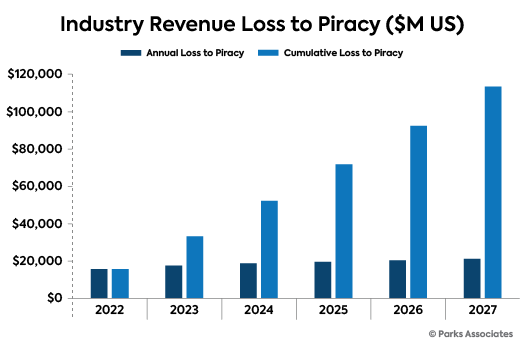Summary
This study provides a comprehensive view of piracy threats and the evolution of anti-piracy techniques along with five-year forecasts of revenue loss in the US market for video service providers.

ページTOPに戻る
Table of Contents
Table of Contents
Definition: What is piracy?
Key questions and research approach
Executive Summary
Industry insights
Key findings: The impact of piracy
The piracy-antipiracy life cycle
Consumer Attitudes Toward Piracy
Consumer insights
Consumer engagement with piracy
Intention of Subscribing to a TV Service in Next 6 Months
Piracy Tool Used
Consumer Engagement in Piracy and Account Sharing
Average Percentage of Households Giving or Receiving Account Credentials
Pirate Tool Usage in OTT Service Business Models
Strong Agreement Towards Unlicensed Video Media Usage
Impact of Lower Pricing on Pirating Tool Users
Why Protect Against Piracy?
Revenue Loss to Piracy, All US Households ($M US)
Lifecycle of a Video Asset
Live Events: Decline in Value
The purpose of security
Key rationale for security
Protecting reputation and fighting piracy
Reducing the risk of theft, preserving revenue
Consumer Engagement in Piracy and Account Sharing
Additional consumer-facing paths to piracy
Meeting obligations, maintaining advertising integrity, and preserving reputation
Optimizing distribution
Piracy Life Cycle: Recognizing Piracy
The piracy-antipiracy life cycle: Recognition of piracy
Piracy orders of magnitude
The piracy ecosystem, from a distributor’s perspective
Piracy Life Cycle: Acquisition by Pirates
The piracy-antipiracy life cycle: Acquisition of content and services by pirates
Where theft occurs, from a video distributor’s perspective
Pirates steal services and content
Pirates compromise service delivery infrastructure, devices and software
Pirates exploit consumer access
Pirates exploit a variety of alternatives to capture content
Pirates profiting from stolen (legitimate) advertising
Pirates profit from fraudulent advertising (malvertising)
Close-up: examples of ransomware ads
Piracy Life Cycle: Distribution
The piracy-antipiracy life cycle: distribution
Consumer-to-consumer distribution: it’s not piracy if it’s allowed by rights-holder
Business-to-consumer distribution by pirates
Online distribution: peer-to-peer (P2P)
Online distribution: live streaming
Online distribution: media centers and app stores as hosts to pirate apps
Online distribution: compromised devices
Online distribution: illicit streaming devices (ISDs)
Online distribution: retail “IPTV” services
IPTV business models: consumer-facing offers
Setting up a piracy operation: choose a service platform and back-end
Close-up: the profits from piracy far outweigh the costs
Piracy business models: piracy-as-a-service
Piracy-as-a-service: outsource the entire operation, including the content
Piracy Life Cycle: Detection & Deterrence
The piracy-antipiracy life cycle: Piracy detection and deterrence
Piracy deterrence: pay TV and streaming security
Pay-TV antipiracy: detection through watermarking & monitoring
Piracy deterrence: platform requirements for usage monitoring and analytics
Piracy deterrence: protecting apps from penetration and reverse engineering
Piracy deterrence: service parameters and administration practices
Piracy deterrence: best practices for service administration
Piracy deterrence: conceptual guidelines
Piracy deterrence: business rules should guide detection parameters
Summary: components of an antipiracy framework
Piracy Life Cycle: Mitigation and Engagement
The piracy-antipiracy life cycle: mitigation & ecosystem engagement
Piracy mitigation: end-user mitigation practices and infrastructure and network issues
Piracy mitigation: operations and vendor administration
Ongoing deterrence: operations practices and countermeasures
Ecosystem Approaches Against Piracy
Non-technical countermeasures: ecosystem engagement
Industry collaborations against piracy: Americas
Antipiracy approaches differ region-to-region
Additional Piracy Use Cases
Cases: illegal distribution via ‘IPTV’ sites and illicit streaming devices (ISDs)
Cases: ransomware / piracy-as-a-service
Cases: VASTFLUX – exploiting ad automation by fraud
Cases: antipiracy through collaboration
Piracy Forecast
Market drivers and barriers
US Streaming Video Households (Millions)
US Streaming Revenue per Household ($US)
Streaming revenue - All US Households ($M)
Piracy Rate, Percentage of Streaming Revenue
Annual Revenue Loss to Piracy, per US HH ($US)
Revenue Loss to Piracy, All US HH ($M US)
Monthly Revenue Loss by Video Type ($M US)
Annualized Revenue Loss by Video type ($M US)
TV Piracy by Programming Type
Fraudulent Advertising to Web and Mobile - 2022-2027 ($M)
Breakout of Ad Fraud between Web and Mobile ($M)
Appendix: Key Suppliers
Core security / antipiracy suppliers and their security categories
Leaders in antipiracy products and solutions
Appendix: Definitions
Appendix: Piracy Reference
Appendix: Methodology



.png)

